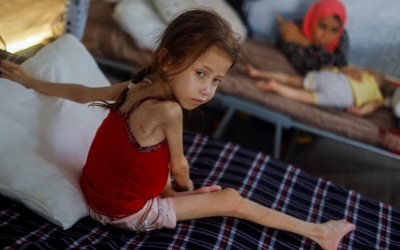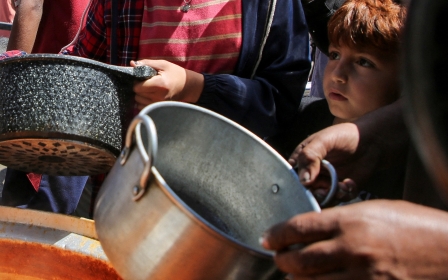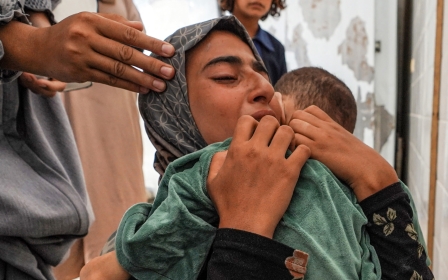War on Gaza: Famine threat persists as half a million starving, monitor finds

A high risk of famine persists across the Gaza Strip as almost the entire population faces high levels of acute food insecurity or worse, including half a million suffering starvation, according to a global hunger monitor.
The report by the Integrated Food Security Phase Classification (IPC) published on Tuesday found that over 20 percent of Gaza's 2.2 million population households go entire days and nights without eating, amid the eight-month Israeli war and siege on Gaza.
More than half of Palestinian households have exchanged their clothes for money to buy food, while a third have had to pick up trash to sell, the UN-backed report added.
In March, the IPC warned that famine was imminent in Gaza, projecting it could happen by the end of May.
The report piled pressure on Israel, which had for months imposed a tight siege on the Palestinian enclave blocking the delivery of basic life-saving food and medical items.
New MEE newsletter: Jerusalem Dispatch
Sign up to get the latest insights and analysis on Israel-Palestine, alongside Turkey Unpacked and other MEE newsletters
Independent UN investigators say Israel used starvation of the Palestinian population as a weapon of war as part of a policy that amounts to collective punishment of civilians.
Amid international outrage, Israeli authorities “slightly” improved food access in some areas, alleviating the threat of imminent famine projected in March, according to the IPC.
'The situation in Gaza remains catastrophic and there is a high and sustained risk of famine across the whole Gaza Strip'
- UN-backed IPC report
However, the situation has deteriorated in recent weeks with residents saying severe Israeli restrictions are back, escalating the starvation crisis again.
Israel's ground invasion of Rafah, in southern Gaza, including its seizure of the Rafah crossing, has choked off the few routes into the enclave for humanitarian aid lorries.
The IPC said the improvements observed after the March report should not "allow room for complacency" about the risk of famine potentially occurring in the coming weeks and months.
"The situation in Gaza remains catastrophic and there is a high and sustained risk of famine across the whole Gaza Strip," the report said.
It added that the "humanitarian space in the Gaza Strip continues to shrink and the ability to safely deliver assistance to populations is dwindling," warning that the "recent trajectory is negative and highly unstable".
'Extreme lack of food'
The IPC does not gather data, but relies on humanitarian partners on the ground to produce information regarding food security, nutrition, mortality and calorie intake. It then analyses that data.
According to the latest projections, the IPC report said 96 percent of Gaza's population face at least high levels of acute food insecurity through September.
Of those, more than 495,000 face “an extreme lack of food, starvation, and exhaustion of coping capacities”.
In addition to widespread Israeli destruction of homes, markets and civilian infrastructure, nearly 60 percent of Gaza's agricultural land has been destroyed or severely damaged, which has significantly impacted the food system, according to IPC.
The risk of disease outbreaks is increased by the "concentration of displaced populations into areas with significantly reduced water, sanitation, hygiene (WASH), health and other essential infrastructure," it added.
Nearly 70 percent of hygiene facilities across Gaza were damaged or destroyed by the end of May.
According to the report, Gaza's health systems also face complete collapse in the coming months, increasing the "likelihood of an epidemic outbreak" and the possibility of a "catastrophe of unprecedented magnitude compared to the suffering already witnessed in Gaza since October".
The IPC considers sustained hostilities and displacement, as well as restricted humanitarian access over the past months, to be key drivers of the situation.
“Only the cessation of hostilities in conjunction with sustained humanitarian access can reduce the risk of a famine.”
In a response to the report, chief executive of Oxfam UK, Halima Begum, said: “The slight improvement of conditions in the north of Gaza shows that Israel can end human suffering when it chooses - but just as quickly those gains can vanish when access is again constrained, as the report warns is happening now.
“Yet again Oxfam urgently calls on the UK government to do more to put pressure on Israel to allow aid to reach more than two million people living in these intolerable conditions, and to stop adding fuel to the fire by allowing the sale of arms to Israel to continue.”
Middle East Eye delivers independent and unrivalled coverage and analysis of the Middle East, North Africa and beyond. To learn more about republishing this content and the associated fees, please fill out this form. More about MEE can be found here.





